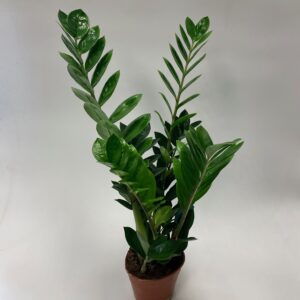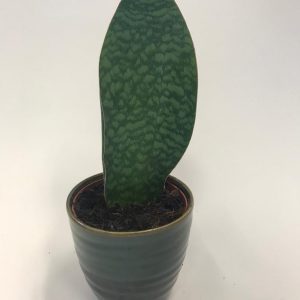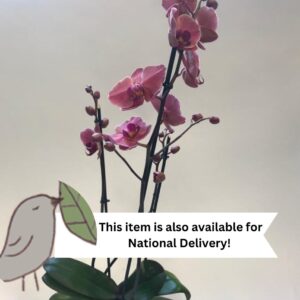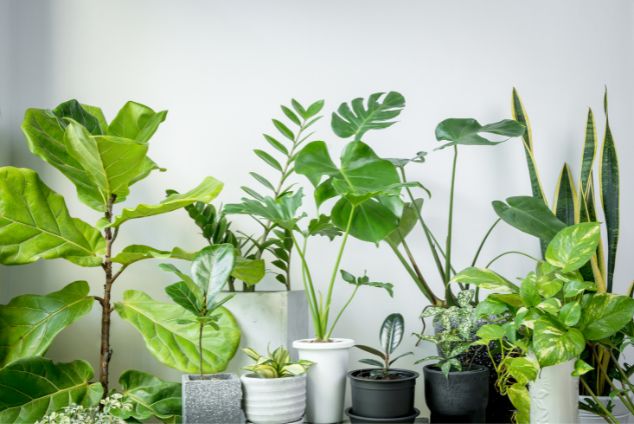Are you struggling to keep your houseplants alive and thriving? Look no further than this comprehensive house plant care guide. It has all the tips and tricks you need to give your green friends the love and attention they deserve.
From basic care to troubleshooting common issues, we’ve got you covered. Discover our guide below and shop our indoor plant range online today.
[button]
Basic houseplant care
When it comes to taking care of your houseplants, there are a few key points to keep in mind:
Light
Proper light exposure is crucial for the health and growth of houseplants. Understanding your plants’ lighting needs is essential for houseplant care.
Different plants have different light requirements, so it’s important to know how much light each plant needs. Some plants thrive in bright light and direct sunlight, while others prefer indirect or low-light conditions.
It’s important to place your houseplants in the right spot, where they can receive the appropriate amount of light.

If your plant isn’t getting enough light, it may become leggy and weak. On the other hand, too much light can cause burning or bleaching of the leaves.
Water

Watering your plants regularly and consistently is essential for their overall health and growth. Plants rely on water to carry nutrients from the soil to their roots, helping them thrive.
In most cases, but not all, water your plants when the top inch of soil feels dry to the touch. Using a watering can with a narrow spout, gently pour water directly onto the soil, avoiding the leaves as much as possible. Check your specific plant type before watering to ensure you’re giving it the right amount of water.
Be mindful not to overwater your plants, as this can lead to root rot and other issues. Remember, different plants have different water requirements, so it’s important to research and understand the needs of each plant in your care.
Soil
The soil in your houseplants’ pots should be well-draining to prevent waterlogged roots and promote healthy growth. Here are four important things to consider when it comes to your plant’s soil:
- Composition: A good potting mix consists of a combination of organic matter like peat moss or compost and inorganic materials like perlite or vermiculite. This blend provides a balanced environment for your plants’ roots.
- pH level: Different plants thrive in different pH levels. Testing the soil’s acidity or alkalinity can help you adjust it to meet your plant’s specific needs.
- Nutrient content: Plants rely on the soil for essential nutrients. Look for a potting mix with balanced nutrients like nitrogen, phosphorus, and potassium.
- Aeration: Proper aeration is crucial for root health. Ensure the soil allows air circulation and doesn’t become compacted over time.

Fertiliser

Choosing the right fertiliser for your houseplants is essential for providing them with the necessary nutrients for healthy growth.
There are various fertiliser options available in the market. First, consider the type of houseplants you have. Different plants have different nutrient requirements. For example, flowering plants may benefit from a fertiliser with a higher phosphorus content, while foliage plants may require a balanced fertiliser.
Next, consider the fertiliser’s NPK ratio, which indicates the proportion of nitrogen (N), phosphorus (P), and potassium (K) it contains. This ratio will determine the fertiliser’s effectiveness in promoting growth, blooming, and overall plant health.
Additionally, consider using organic fertilisers derived from natural sources and provide a slow release of nutrients.
Always follow the fertiliser packaging instructions and apply it in the recommended amounts and frequency.
Temperature and humidity
Maintaining the proper temperature and humidity levels is crucial for the health and well-being of your indoor plants. Here’s what you need to know:
- Temperature: Most houseplants thrive in temperatures between 18°C – 24°C. Avoid placing your plants near drafty windows or heating vents, as extreme temperature fluctuations can stress them.
- Humidity: Many indoor plants originate from humid environments, so providing adequate humidity is essential. You can increase humidity by placing a tray of water near your plants or using a humidifier. Mist your plants regularly to keep their leaves moist.
- Monitoring: Invest in a thermometer and hygrometer to keep track of temperature and humidity levels. This will help you ensure that your plants are in a comfortable environment.
- Adjusting: If you notice your plants showing signs of distress, such as wilting or yellowing leaves, it may be a sign that the temperature or humidity levels need adjusting. Make the necessary changes to create a healthier environment for your green friends.

Popular houseplants for UK homes
Looking to add some greenery to your home but don’t have a green thumb? No worries! We’ve got you covered with a discussion on easy care, low-light plants, flowering plants, tropical plants, and even herb gardens.
Whether you’re a beginner or a busy bee, these plant options will thrive in your home and require minimal maintenance.
Easy care, low light plants
-
 ZZ plant£40.00
ZZ plant£40.00 -
 Sharks Fin Sanseveria£30.00
Sharks Fin Sanseveria£30.00
If you don’t have much natural light in your home, plenty of houseplants will thrive in low-light conditions. Here are four easy-care plants that will brighten up your space without requiring a lot of sunlight:
- Snake Plant (Sansevieria): Snake plants are tough plants that can tolerate low light and irregular watering. Its striking, upright leaves add a touch of elegance to any room.
- ZZ Plant (Zamioculcas zamiifolia): The ZZ plant is known for its ability to survive in almost any lighting condition. It has shiny, dark green leaves that bring a lush, tropical feel to your home.
- Pothos (Epipremnum aureum): Pothos is a popular choice for low-light areas. Its trailing vines can be easily trained to climb or hang, making it a versatile and beautiful addition to your home.
- Peace Lily (Spathiphyllum): This classic houseplant has beautiful white flowers and glossy, dark green leaves. It can tolerate low light but prefers some indirect sunlight to bloom.
- Spider plant: Spider plants are one of the most popular houseplants in the UK due to their easy care, attractive foliage, and ability to thrive in a variety of light conditions. With their cascading leaves and fast growth, spider plants add an ornamental element to shelves and hanging baskets while also being tolerant of occasional neglect.
Flowering plants
-
 OrchidPrice From: £29.95
OrchidPrice From: £29.95
Flowering plants add a burst of colour and beauty to any space, brightening up even the darkest corners of your home. They are a wonderful addition to your indoor garden, bringing a touch of nature inside. Here are four popular flowering plants:
- Orchids – Orchids come in stunning colours and exotic shapes. They are very popular for their beautiful, long-lasting flowers. They thrive in indoor conditions and bloom repeatedly if cared for properly.
- African Violets – African violets produce fuzzy, brightly coloured flowers. They bloom often and are relatively easy to care for. They work well as accent plants in bathrooms or on windowsills.
- Chrysanthemums – Also known as mums or chrysanthemums. They come in a huge range of colours and bloom in late summer/autumn. They’re popular for holiday displays and as gifts.
- Christmas Cactus – Christmas cacti are prized for their sprays of tube-shaped winter flowers. They are easy to care for and propagate, which adds to their popularity as houseplants. Their winter blooming also makes them a festive addition around the holidays.
Tropical plants
To successfully grow tropical plants in your home, creating a warm and humid environment that mimics their natural habitat is essential. Here are some popular tropical, green foliage plants in the UK:
- Monstera – Monsteras have large, glossy, signature split leaves. They grow quickly and add a tropical jungle feel to any space. They are easy to care for and propagate, which adds to their popularity.
- Philodendrons – Philodendrons come in vining and non-vining varieties. They have lush, heart-shaped leaves and are tolerant of lower light conditions. This makes them an excellent choice for beginners.
- Calathea – Calatheas have colourful, patterned leaves that are distinctly tropical-looking. They thrive in warm, humid conditions.
- Ferns – Ferns thrive in the warm, humid conditions. Varieties like Boston ferns and maidenhair ferns have delicate, lacy fronds that look great in hanging baskets.
Herb gardens
Growing herbs in your garden can provide you with a fresh and flavourful addition to your meals. Not only do they add a burst of taste to your dishes, but they also offer numerous health benefits. Here are popular herbs to grow in the UK:
- Basil – Basil is easy to grow and highly useful for cooking. It thrives on a sunny windowsill and can be grown year-round with adequate light. The scent and flavour make it a must for any indoor herb garden.
- Mint – Mint grows vigorously and spreads quickly, making it an excellent choice for beginners. It can be planted in containers to prevent spreading. Mint is popular for its refreshing scent and flavour.
- Rosemary – An aromatic herb perfect for seasoning roasted veggies and meats. Rosemary prefers lots of light. Growing it indoors means having fresh rosemary all year round.
- Thyme – Thyme flourishes indoors with ample sunlight. Its versatility for cooking meats, stews, and soups makes thyme a staple herb for indoor herb gardens in UK kitchens.

Seasonal plant care
When it comes to caring for plants in winter, summer, and during the holidays, there are a few key points to keep in mind:
Caring for plants in winter
Adjusting your house plant care routine during winter is essential to ensure their survival. Here are four essential tips to help you keep your plants healthy and happy during the colder months:

- Reduce watering: With lower light levels and cooler temperatures, plants need less water during winter. Make sure to check the soil’s moisture before watering, and only water when the top inch feels dry.
- Increase humidity: Central heating can dry out the air, which can be detrimental to your plants. Place a humidifier near your plants or use a tray filled with water and pebbles to create a humid environment.
- Provide adequate light: Days are shorter during winter, so it’s important to provide enough light for your plants to thrive. Consider moving them closer to windows or using artificial grow lights.
- Watch for pests: Pests may become more of a problem during winter when plants are stressed. Keep an eye out for signs of infestations, such as yellowing leaves or sticky residue, and take appropriate action if needed.
Summer plant care
Adequate sunlight, water, and regular fertilisation are essential for keeping plants healthy and thriving in the summer.
During this warm season, your plants need plenty of sunlight to fuel their growth and photosynthesis. Place them near windows or in well-lit areas to ensure they receive at least six hours of direct sunlight each day.
Watering is crucial in the summer, as the heat can quickly dry out the soil. Check the moisture level regularly and water deeply when the top inch of soil feels dry.
Additionally, fertilise your plants every two weeks with a balanced liquid fertiliser to replenish the nutrients they need for robust growth.

Troubleshooting common issues
In this section, you’ll learn how to troubleshoot common issues with your plants:
Identifying pests and treating infestations properly
Check for any signs of pests on your house plants, and remember to treat any infestations promptly. Pests can wreak havoc on your beloved greenery if left unchecked. Here are four key steps to help you identify and treat any pest infestations:
- Inspect: Look closely at your plants, examining the leaves and stems for any signs of trouble. Look for small holes, discoloured spots, or sticky residue, which may indicate the presence of pests.
- Identify: Once you’ve spotted some suspicious signs, it’s essential to identify the specific pest causing the damage. Common culprits include aphids, mealybugs, spider mites, and fungus gnats. Research each pest’s characteristics to determine the best course of action.
- Remove: Depending on the severity of the infestation, you may need to physically remove the pests from your plants. Use a gentle stream of water to wash away aphids or mealybugs, or manually pick them off. For spider mites, consider using insecticidal soap or neem oil.
- Prevent: To prevent future infestations, maintain a clean and healthy environment for your plants. Regularly wipe down leaves, keep a close eye on new additions to your collection, and isolate any plants that show signs of pests until the issue is resolved.
Fixing problems like leaf browning, leaf drop, yellowing leaves
To address leaf browning, leaf drop, or yellowing leaves, you should first assess your plants’ watering routine. Overwatering or underwatering can both lead to these issues.
Check the soil moisture regularly by sticking your finger about an inch deep into the soil. If it feels dry, it’s time to water. If it feels wet or damp, hold off on watering.
Also, make sure your plants are getting the right amount of sunlight. Some plants require more light than others, so check their specific needs.
Lastly, consider the humidity levels in your home. Dry air can cause leaf problems, so misting your plants or using a humidifier can help.
Treating disease issues like root rot, mould/fungus
Ensure you’re looking for signs of root rot or mould/fungus, as these can be harmful to your plants. Here are four things you can do to treat these disease issues
- Check the soil moisture: Overwatering is a common cause of root rot and mould/fungus growth. Make sure the soil is not consistently wet and provide proper drainage.
- Remove affected leaves: If you spot any signs of root rot or mould/fungus on the leaves, remove them immediately to prevent further spread.
- Adjust humidity levels: Some plants are more susceptible to mould and fungus in high humidity. Consider using a dehumidifier or placing your plant in a well-ventilated area.
- Use fungicides: If the problem persists, you can use a fungicide specifically designed for houseplants to control and prevent further growth of mould and fungus.
Pruning and shaping
When it comes to pruning and shaping your plants, there are several benefits you can enjoy.
Pruning helps promote healthy growth, remove dead or damaged branches, and improve the overall appearance of your plants.
To effectively prune, you’ll need the right techniques and tools, such as pruning shears or loppers, to make clean cuts and avoid damaging the plant.
It’s also important to know when to prune, as timing can vary depending on the type of plant and its growth cycle.
Benefits of pruning
Pruning helps your house plants grow healthier and look more attractive. Here are four benefits of regular pruning:
- Encourages new growth: Removing dead or damaged branches allows your plant to focus its energy on new growth. This stimulates the production of new leaves and flowers, making your plant look more vibrant and lush.
- Controls size and shape: Pruning allows you to shape your plant and prevent it from becoming too leggy or unruly. By trimming back excessive growth, you can maintain a compact and well-proportioned plant that fits perfectly in your space.
- Improves air circulation: Removing crowded or crossing branches opens the canopy, promoting better air circulation. This reduces the risk of fungal diseases and pest infestations, keeping your plant healthy and thriving.
- Enhances flowering: Some plants produce flowers on new growth. Pruning stimulates this new growth, leading to an abundance of beautiful blooms. So, by regularly pruning your house plants, you can enjoy a spectacular display of flowers throughout the year.
Techniques and tools
When it comes to pruning, you want to ensure you have the necessary tools to get the job done effectively. A good pair of pruning shears is a must-have for cutting through branches and stems. Make sure they’re sharp and clean to avoid damaging the plant. A hand pruner or pruning saw may also be necessary for thicker branches.
As for techniques, start by removing any dead or diseased branches. This will promote healthy growth and prevent the spread of disease. You can also trim back overgrown branches to maintain the desired shape of the plant. Remember to always prune just above a bud or leaf node to encourage new growth.
When to prune
It’s important to be aware of the best time to prune to ensure optimal growth and health for your plants. Pruning at the right time can help promote new growth, maintain the shape of your plants, and prevent diseases.
Here are four key factors to consider when deciding when to prune your house plants:
- Dormancy: Most plants go through a period of dormancy during the winter months. This is the ideal time to prune as it minimises stress on the plant and allows for easier healing.
- Growth season: It’s best to prune in the early spring or summer for plants that are actively growing. This will encourage new growth and help maintain the overall shape and size of the plant.
- Flowering plants: If you have flowering plants, it’s important to prune them right after they finish blooming. This will ensure that you don’t remove any potential flower buds for the next season.
- Maintenance pruning: Regular maintenance pruning can be done throughout the year to remove dead or damaged leaves, branches, or stems. This helps keep your plants looking neat and healthy.
Shop high-quality house plants
Taking care of your houseplants doesn’t have to be a daunting task. By following basic care guidelines and choosing the right plants for your home, you can create a thriving indoor garden. Growing and caring for your own plants can be a fun and rewarding task, and we are always happy to advise along the way.
Looking for some new house plants to add to your home? Shop our wide range of indoor plants and brighten up your space today.
Frequently asked questions
You should repot your houseplants every 1-2 years. Look for signs like roots growing out of the drainage holes or the plant becoming root-bound. Choose a slightly larger plant pot and fresh soil.
Yes, you can use tap water to water your houseplants, but it’s best to let it sit for a day to allow chlorine to evaporate. Filtered or distilled water is also a good option.
Yes, several houseplants are safe for pets. Some examples include spider plants, Boston ferns, and African violets. These plants are non-toxic to cats and dogs, making them a great choice for pet owners.
To propagate your houseplants:
- Start by choosing a healthy plant.
- Cut a stem or leaf and place it in water or soil.
- Keep it in a warm, well-lit area and watch it grow into a new plant.
Observe your houseplant’s leaves to determine whether it is getting enough sunlight. If they are pale, elongated, or drooping, they may not be getting enough light. Move it to a brighter spot.


